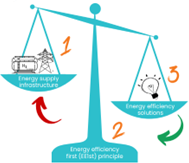The ODYSSEE-MURE project now links the top-down energy savings (obtained from the ODYSSEE tools) and bottom-up energy savings (obtained from the MURE tools) to an evaluation of the Multiple Benefits of Energy Efficiency with the MICATool.
The evaluation can be started through the following link.
Details on the approach and results of such an evaluation are available in the documentation Updated Facility on Multiple Benefits of Energy Efficiency.
The ODYSSEE-MURE project has been pivotal in operationalising the Multiple Benefits of Energy Efficiency (see Reuter et al., 2020)
Multiple Benefits of Energy Efficiency (MB) are strongly linked to the Energy Efficiency First (EE1st) principle (Article 3 EED 2023):
- Article 3(5a) states: "In applying the energy efficiency first principle, Member States shall promote and, where cost-benefit analyses are required, ensure the application of, and make publicly available, cost-benefit methodologies that allow proper assessment of the wider benefits of energy efficiency solutions where appropriate, taking into account the entire life cycle and long-term perspective, system and cost efficiency, security of supply and quantification from the societal, health, economic and climate neutrality perspectives, sustainability and circular economy principles in transition to climate neutrality."
- Article 3(5b) requires Member States to “address the impact on energy poverty” in applying the EE1st principle
- Article 3(5d) provides for Member States to report on how the EE1st principle has been integrated into their NECP progress reports, including “an assessment of the application and benefits” of the principle.
Why are Multiple Benefits important?

 Ignoring multiple impacts undermines the cost-effectiveness of energy efficiency solutions
Ignoring multiple impacts undermines the cost-effectiveness of energy efficiency solutions
 The EE1st principle calls for a fair comparison of energy supply and energy efficiency in energy related decisions
The EE1st principle calls for a fair comparison of energy supply and energy efficiency in energy related decisions
 Assessment of multiple impacts, shifting the economic balance in favour of energy efficiency
Assessment of multiple impacts, shifting the economic balance in favour of energy efficiency



